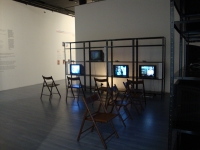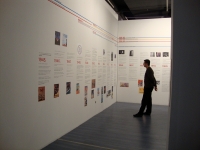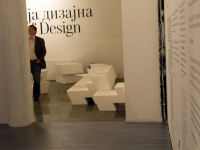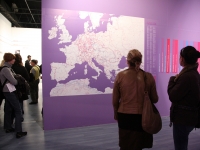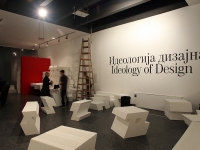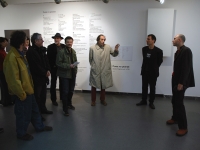ID: Ideology of Design
Exhibition ID: Ideology of Design
Curators and production of the exhibition: New Media Center_kuda.org
23 October – 23 November, 2009
Museum of Contemporary Art of Vojvodina, Dunavska St. 37, Novi Sad
More about the project: http://www.kuda.org/en/exhibition-id-ideology-design
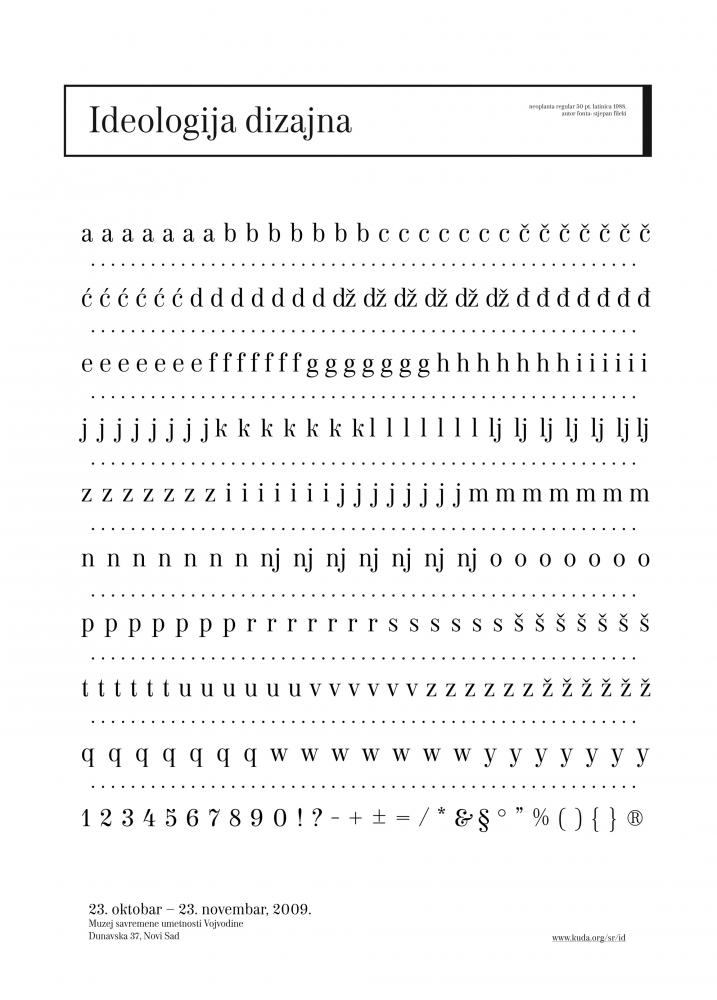 In what way are design practices perceived and understood today and in what way can one follow their crucial development during the last decades of the 20th century and their connections with artistic practices and critical discourses? Planning for mass production, graphic design, industrial design, design of environment, advertising, interior design, fashion design etc. are but some of the determinants of this complex discipline of culture. Whether we examine its development in socialism or capitalism, design is always in close and dynamic connection with the economic and productive bases of society, building different and/or specific relationships of man with material culture. The object of researching and Ideology of Design exhibition are theories and practices (of industrial and graphic) design that were taking place during almost half a century of the socialist Yugoslavia, and their wider social and ideological context.
In what way are design practices perceived and understood today and in what way can one follow their crucial development during the last decades of the 20th century and their connections with artistic practices and critical discourses? Planning for mass production, graphic design, industrial design, design of environment, advertising, interior design, fashion design etc. are but some of the determinants of this complex discipline of culture. Whether we examine its development in socialism or capitalism, design is always in close and dynamic connection with the economic and productive bases of society, building different and/or specific relationships of man with material culture. The object of researching and Ideology of Design exhibition are theories and practices (of industrial and graphic) design that were taking place during almost half a century of the socialist Yugoslavia, and their wider social and ideological context.
Design is a pregnant and highly interdisciplinary field which includes achievements from culture, science, architecture, technology and artistic practice, and thus represents a fertile soil for sociological and philosophical discussions on technology and market, about the social and political-economical dynamics and the labor process. A special aspect of the project was set on discussions and practices led at the time of socialist Yugoslavia which tried to define the role of design in a (non-)market socialist economy, its functionalism and its being conditioned by the market, or its social engagement, and the role of design in forming a new relationship of man with material objects, a new way of life towards establishing a classless human community. Developing progressive, critical and contradictory positions, design was simultaneously presented a symbol of a post-war reconstruction of a country under the wing of industrialisation and liberation of man from material privation, but as decades went by it played more and more one of the main roles in building a socialist market society.
Research work, exhibition and publications of the Ideology of Design deal with contextualisation of contradictory processes refracted through theory and practices of design and, parallel to this, the way by which different ideologies of design and visual identities were created in the first post-war period of forming Yugoslavia, then during the tempestuous 1960s and 1970s until the very end when this community ceased to exist. Also, this project re-examines the chance to create a relationship between critical and historical practices of design and contemporary design, which is more and more seen as something belonging to the exclusively commercial aspect of creative industries, which, refracted through an ideological prism of neoliberal capitalism preserve the exploiting relationship regarding creativity and the creative person. In this sense, a question arises: Is it possible today to observe and practice design outside of the dominant functionalist principles and the market-dictated production and consumption, and to develop their engaged dimension in creating more humane social relations, i.e., is it possible to conduct politization of design practices during “transition” times?
ID: Ideology of Design is a part of the Individual Utopias Now and Then project which is realised in cooperation with SCCA/pro.ba from Bosnia and Herzegovina and T.I.C.A. from Albania. Also, the project is an integral part of a long-term research project called Art Always Has Its Consequences, and four organisations are cooperating in this project: WHW from Croatia, tranzit.hu from Hungary, Museum Sztuki from Poland and Centar_kuda.org from Serbia in the period between 2008 and 2010.
Ideology of Design is comprised of a couple of entireties, and of those didactic exhibition stands out, with the represented:
– Video recordings – interviews – with some of the most important protagonists of the Yugoslav theory and practice of design and history and art criticism, and among them are Jerko Denegri and Branko Vučičević from Belgrade, Matko Meštrović and Fedor Kritovac from Zagreb, Stane Bernik from Ljubljana and Branislav Dobanovački from Novi Sad. The series of interviews realised for the Ideology of Design project will be joined with an interview with Ivan Picelj, a graphic designer from Zagreb, on the occasion of the anniversary of Helvetica type, which was realised by Dragan Mileusnić and Željko Serdarević, a designer couple from Zagreb.
– In a joint production, Zagreb designer Dejan Kršić and Center_kuda.org within the exhibition present a subjective timeline to the practices of industrial and graphic design, and institutional and alternative frameworks of design practices related to the paradigmatic social political and economical events in the socialist Yugoslavia.
– Spatial intervention of two art and designers’ collectives, Metahaven from Holland and Société Réaliste from France.
– “Total design” of the exhibition is completed by the mobile and modular furniture “Z” blocks made after the design of NAO – Normal Architecture Office and Srđan Jovanović Weiss from Philadelphia, USA.
– Workshops and educational-collaborative programmes will be organised and realised by two Novi Sad initiatives of young generation designers – Open Design Studio and A3.Format project.
– Public discussions and presentations will be organized during the one month of the exhibition, with some of the protagonists from contemporary scene of design theory and practice, such is design theorist Feđa Vukić from Zagreb, designer and writer Dejan Kršić from Zagreb and Borut Vild – designer from Belgrade. Precise program of the public discussions will be announced in the following days.
– Reader – Apart from the spoken programme that takes place during the exhibition, the discursive platform of the project is completed by the bilingual reader containing 13 collected essays which provide a theoretical insight into the project theme published by Autonomedia from New York. Among the authors of the essays you will find the works of: Jean Baudrillard, Igor Chubarov, an interview with Jerko Denegri, Branislav Dimitrijević, Hal Foster, Dejan Kršić, Nenad Malešević, Metahaven, Borislav Mikulić, Barbara Predan, Jacques Rancière, Feđa Vukić and WHW collective, editor: Branka Ćurčić, ISBN 978-1-57027-209-7, design of the reader: Peter Gregson Studio, Novi Sad
Design of the posters and the leaflet (later also the catalogue) of the exhibition and the project is realized by Filip Bojović, creative director of the FajnHajp from Novi Sad. In design of the posters and leaflet, type font Neoplanta BG is used, which was in 1988 constructed by the Belgrade based typographer – Stjepan Fileki. Type font is freely available for further use at: www.tipometar.org
ID: Ideology of Design is an integral part of a long-term research project called Art Always Has Its Consequences, and four organisations are cooperating in this project: WHW from Croatia, tranzit.hu from Hungary, Museum Sztuki from Poland and Centar_kuda.org from Serbia in the period between 2008 and 2010. The project is dedicated to creating and distributing new discoveries and knowledge about paradigmatic socially engaged practices in art and design in the region and in the Eastern Europe, including their relationship with the wider European context in the past and now. Also, the exhibition is a part of the Individual Utopias Now and Then project which is realised in cooperation with SCCA/pro.ba from Bosnia and Herzegovina and T.I.C.A. from Albania.
ID: Ideology of Design project is supported by:
Culture 2007-2013, European Commission
Swiss Cultural Programme in the Western Balkans
ERSTE Stiftung
Ministry of Culture of Republic of Serbia
Ministry of Culture of Province Vojvodina
KDS, Novi Sad
www.kuda.org/en/id
www.artalways.org
As a result of this comparative case study is a publication.

